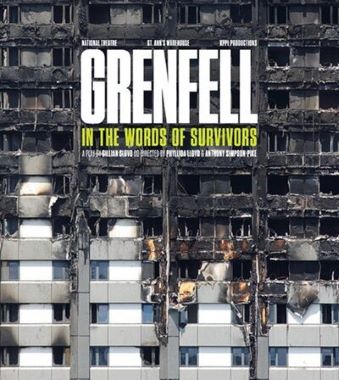THE FLAMES OF INJUSTICE
Documentary theatre, a.k.a. docudrama, uses existing nonfiction sources to create works of performance that reenact historical events. My earliest recollection of docudrama was Twilight, Los Angeles 1992, written by performer Anna Deavere Smith from interviews with people involved in the L.A. Riots that followed the acquittal of the police who brutally beat Rodney King. Using their words verbatim, she played each character, later doing the same with Notes from the Field about health care. Other examples of docudrama include Jessica Blank and Erik Jensen’s The Exonerated, which used words from wrongfully convicted inmates, and The Laramie Project, interviews of the people who lived in Laramie during the Matthew Shephard murder, compiled and performed by Moises Kaufman and members of the Tectonic Theater Project (Tectonic’s Here There Are Blueberries about those who worked at Auschwitz just opened at NYTW). Now, London’s The National Theatre brings us Grenfell, about the low-income, subsidized 24-story tower that tragically went up in a blaze of fire on June 14, 2017, killing 72 people. The subtitle is “In the words of survivors.”
The company of Grenfell
The versatile black box theater at St. Ann’s Warehouse — where Grenfell opened tonight — is set up with the audience seated on four sides of a rectangular stage. The only set pieces are 11 boxes centerstage — worn cartons with lids, the kind that might hold personal possessions when you move. Set and costume designer Georgia Lowe also hangs monitors over each side of the audience. Without dimming the house lights, 11 actors enter the playing space from all around. Individually, they introduce themselves and describe the primary character they’ll be playing.
Gaz Choudhry
They also explain that every word comes from interviews with the actual people they’re playing. Other verbatim sources include court documents, emails, and news reports. After defining some British terms that would be used, they describe the play as a performance about community, and therefore ask the audience to introduce themselves to a nearby neighbor. I spoke to a married couple in front of me. They were from Chelsea and loved the last production they saw here — The Jungle. I said nice things about The Hunt at St. Anne’s.
Houda Echouafni
The play begins as characters describe how they became eligible to move into Grenfell. The community that lived in the building were mostly immigrants and their children, with many different ethnicities and religions. Act I covers the seven years up to the fire; Act II covers the fire and the investigation that follows. Azusa Ono’s light design continuously jumps with isolating lights from person to person as all the interviews are edited together. It’s three hours of play by play, step by step of what happened and why it happened. With endless facts but no charges or justice after the fire, the knot in my stomach was that of disgust — how corporate greed, racism, and incompetency allowed this tragedy to play out.
Joe Alessi, Dominique Tipper, and Houda Echouafni
Gillian Slovo is credited as the playwright, though the words are not hers. She most likely gathered all the words and evidence and stitched them together. Staged by Phyllida Lloyd and Anthony Simpson-Pike, the performances come off as factual and earnest, without any sentimentality or emotion. Reminiscent of Brecht’s Epic Theater, the audience is constantly reminded that we are in a theater, listening to actors — keeping us intellectually involved in hopes of inciting action. Despite the subject matter, we aren’t allowed to engage except on an intellectual level.
Houda Echouafni
Not exactly my cup of tea for a theater experience, the performance is nonetheless perfect for anyone who wants to investigate the facts of that tragic night without getting emotionally involved. That is, until the end, when a quarter of the audience is moved onto the stage to sit on the floor — a movie screen is lowered to show the names of the victims who didn’t make it out alive. It’s a touching memorial followed by filmed interviews of the actual survivors of Grenfell who further describe how the community remains strong and connected, with silent protest marches continuing today. At this juncture, protest signs are handed out and the entire audience is led in a silent march of our own, ending outside of the theater, asking us to share this experience, demanding justice for this tragic event.
Michael Shaeffer and Dominique Tipper
The evening began as Epic Theater, then turned into Memorial Theater, and ended as Agitprop Theater. I was reminded of the 1935 Clifford Odets play Waiting for Lefty by the Federal Theater Project; theater historians describe the audience leaving the theater in protest, with signs demanding that the New York Cab Driver’s union go on strike. I wonder if after walking a block or two, Odets’ audience dissipated and went about their business. Because that is pretty much what happened to me after Grenfell.
The company and audience of Grenfell outside of St. Ann’s Warehouse
Bravo to the fully committed acting company: Joe Alessi, Gaz Choudhry, Jackie Clune, Houda Echouafni, Mona Goodwin, Keaton Guimarães-Tolley, Ash Hunter, Rachid Sabitri, Michael Shaeffer, Dominique Tipper, and Nahel Tzegai.
Dominique Tipper
photos by Teddy Wolff courtesy of St. Anne’s Warehouse
Grenfell: In the Words of Survivors
National Theatre
St. Ann’s Warehouse, 45 Water St in Brooklyn (on the waterfront in Brooklyn Bridge Park)
3 hours with interval
ends on January 21, 2024
for tickets, visit St. Anne’s Warehouse

